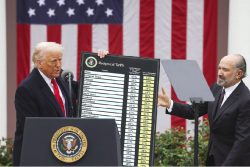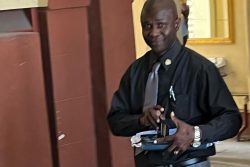The government yesterday used its majority in the National Assembly to pass the Protected Areas Bill with minor amendments, even as concerns were raised by the opposition about it being a mechanism to access funding to implement the Low Carbon Development Strategy (LCDS).
The bill was passed after the government agreed to six of the 13 amendments proposed by PNCR-1G MP Mervyn Williams. Williams,

while presenting on the bill yesterday, also requested that it be sent to a select committee so that “the many questions and inconsistencies” could be ironed out.
Agriculture Minister Robert Persaud, in piloting the bill, said that the piece of legislation will bring the country into international conventions and would give Guyana more credibility in its discussions and negotiations within the climate change arena. He said too that failure to implement the bill would hinder long-term economic and social development. Persaud also said that there was a direct correlation between protected areas and poverty reduction.
The bill, Persaud explained will see the formation of a Protected Areas Commission and Trust, which he said will be given some level of independence in terms of its functioning. He stressed too that the rights of the Amerindian communities would not be taken away by the bill. Persaud also said that the bill would not conflict or duplicate the government’s REDD+ and LCDS thrust. He noted that the protected areas were “wider” than REDD+.

In spite of the assurances given by Persaud, Williams questioned whether the bill was a mechanism being implemented to draw down on the Norway funds, which Guyana is still to tap into. “Mr. Speaker, I should like the Honourable Minister, in whose name this bill was tabled, to tell the National Assembly and indeed the nation whether this bill… is not in fact a mechanism for the implementation of government’s Low Carbon Development Strategy,” the PNCR-1G MP said. He added that while the bill did not say this, several provisions led him to this conclusion. He called for clarification in the interest of transparency.
Williams also questioned aspects of the bill which permitted the President to appoint and to remove members of the Board of Trustees for the Protected Areas Trust. “In the view of the PNCR-1G there is and can be no role for the president in the Protected Areas Bill,” he said.
Consultations
Alliance For Change (AFC) MP Khemraj Ramjattan echoed the sentiments expressed by Williams and also lamented the lack of proper consultations in Amerindian communities. He said that the bill covered so many important areas that it ought to be sent to a select committee.
He said that while his party supported the formation of a Protected Areas regime, questions had to be raised about the timing of the bill. Stating that the bill had come to the House at the “eleventh hour,” Ramjattan suggested that the bill could be used as an avenue to gain money from the international lending agencies which would be used for “elections gimmickry.”

Persaud said that between 2008 and last year, extensive consultations were held with the Amerindian communities. He noted that even before this, consultations had been ongoing.
He did not respond to the comments about the bill being a facility to draw down the money from Norway, saying that he had already addressed the matter.
New challenges
for mining
Meanwhile, Prime Minister Sam Hinds sought to explain how the bill will affect local mining and said it would be positive for the sector since it would provide regulatory certainty. “I would want to encourage our miners that even though there are, maybe, new challenges in this Protected Areas Bill, that it is a good thing for Guyanese and Guyana and that they can adjust to conform to the requirements of this Protected Areas Bill,” Hinds said.
“With this bill, for the foreseeable future, no more than an additional 5 to 10 percent of Guyana’s area may become inaccessible to mining as carried out at the small and medium-scale level of mining but large scale mining will remain possible in those areas if a very strong case can be submitted,” he said.
Hinds said that in the unlikely case that areas miners now hold are included in a proposed protected area, the bill affirms respect for existing rights. “The Minister shall carry out an investigation to determine what rights and claims exist over the area and may take steps to settle such claims and terminate such rights as permitted by law,” Clause 30 says. With respect to proposed areas where there may be mineral and petroleum interests, Clause 31 of the bill states that “the Guyana Geology and Mines Commission (GGMC) shall provide the Minister with adequate information regarding the mineral and petroleum potential of the area and the Minster shall take this information into account before making a declaration.”
Hinds noted that according to the legislation, there are seven categories for the classification of the national protected areas system and stressed that there are restrictions in each of the classes. According to Hinds, in only one of these seven classes, mining is anticipated. This is the Managed Resource Protected Area, and Hinds said that this would be purely artisanal mining or mining where there are limitations on equipment that can be used. He noted, though, that whatever mining is done in these protected areas must be done in accordance with Section 122 of the bill. This section of the bill states that “Any person, except persons under the Amerindian Act, who mines, quarries, drills or removes any minerals, stone, gravel, earth, sand, or other substances or prospects for such substances in a national protected area commits an offence under paragraph 9(a) of the Fourth Schedule”.
Hinds described the piece of legislation as one that was “well thought out.”








